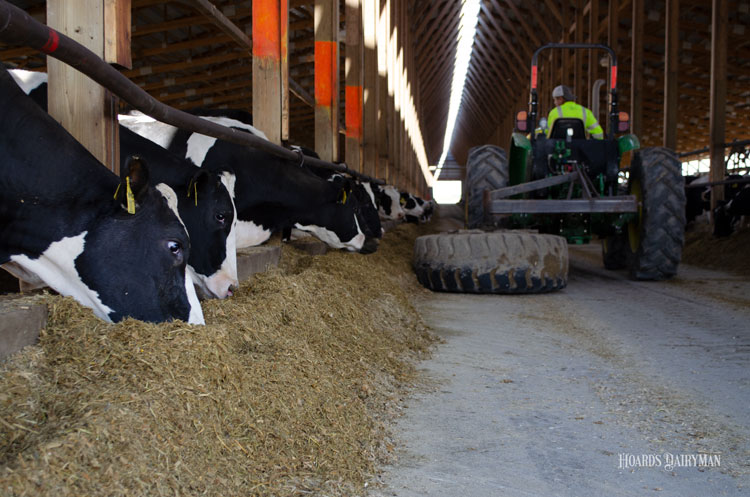
Forage inventories are in rough shape for many. USDA crop reports have suggested stalled corn and bean acres have mostly recovered over the past few weeks, with crop ratings improving. Yet, alfalfa and corn for silage acres may not be anywhere near in-line with this trend. Recent experience throughout Wisconsin, and networking discussion with many crop advisers and consultants from Minnesota and Iowa to Pennsylvania and New York, strongly suggests concern for forages is warranted.
Substantial winterkill the past two years, resulting diet forage changes (more silage or less), and recent challenges planting, growing, and harvesting forage in 2019 are all compounding issues. If you’re experiencing these challenges, know you are not alone. We’re forced to make decisions in the moment that will have an impact both today and in the months to come. Here are a few helpful tips to stay the course and work through limited forage inventories.
Bring consistency to your feedbunk
Consistency can be defined in two ways: 1. Delivering the same ration to your herd each day, and 2. Delivering a balanced nutrient supply each day. The first point is your feeder’s responsibility but the second is your and your nutritionist’s responsibility. Many are now feeding 5 to 10 pounds per cow of feeds such as corn gluten feed, soy hulls, beet pulp, wheat midds, oat hulls, and other such by-products. Ensure your nutrition team understands what these feeds contribute in nutritive value and that the diet is properly balanced. These feeds can vary just like forages so sample them as such to account for variation and uncover hidden value (for example, more protein in a load).
Case in point, corn gluten feed assayed by Rock River Laboratory has averaged around 25 percent crude protein with a roughly 10-unit standard deviation for hundreds of samples collected during the past six months.
Cows don’t have a forage requirement
Consistency should also be maintained month-to-month, not just day-to-day. Some react to dwindling hay inventories by ramping up silage, only to have to then cut back drastically later as silage runs out. Rather than keeping forage levels the same, consider cutting forage back to a sustainable level that will allow a more consistent diet month-to-month. This might not be a popular option, but it is one that brings more consistency for your herd.
We don’t know what the remainder of the growing season (or fall harvest) will hold, thus making decisions geared toward sustained consistency for months is a smart strategy. Feeding 25 pounds dry matter (DM) corn silage in one month and then cutting back to 10 pounds corn silage or less when inventories evaporate substantially impacts the rumen. I’d suggest we’d be better off by cutting forage levels back and feeding a consistent 15 pounds DM per cow and then balancing that out with whatever other feeds we have available. Also, with limited straw quality and availability, consider other effective fiber options such as grass hays, poor-quality alfalfa (there are heaps of this out there), or even oat hulls for dry cow diets. This is a time to think outside the box in feeding your herd.
When forage levels drop, watch effective fiber and feed conversion efficiency
Retired University of Wisconsin-Madison Professor Randy Shaver and others have researched and documented that dry matter intakes rise and feed conversion efficiency can dip when forage levels drop substantially. Further, starch levels should be cut back as well to avoid subclinical acidosis. When forage levels in the diet drop below 40 percent and forage neutral detergent fiber (NDF) dips below 17 to 18 percent of DM, cut back on corn grain. Replace it with additional digestible fiber coming from by-product feeds such as those listed above.
Keep an eye out for total mixed ration (TMR) hygiene issues
With greater intakes come bigger consumed loads of any antinutritional factors in the TMR. This year has been extremely wet and is now trending warmer, increasing the likelihood for fungal and bacterial growth in both feed centers and the feedbunk. Unfortunately, these factors are becoming more common. Clean your equipment vigorously, including the mixer, and more aggressively clean waterers and feedbunks. Keep rainwater and manure away from the feedbunk at all costs and separate manure handling equipment from feeding equipment. Do not drive through dirty areas and then mix or push up feed. Get rid of standing water in the feed areas if possible.
Be proactive and network with grain farmers
Lastly, this year will bring opportunities to chop corn planted for grain in many areas. We will likely be dealing with some level of frosted corn or less than ideal harvest conditions. It’s too difficult to forecast the outcome and potential grain yields to value the potential crop today; however, reach out to local grain farmers in your area and gauge their interest in selling their corn for silage. Identify together what good can come from challenging growing conditions.








